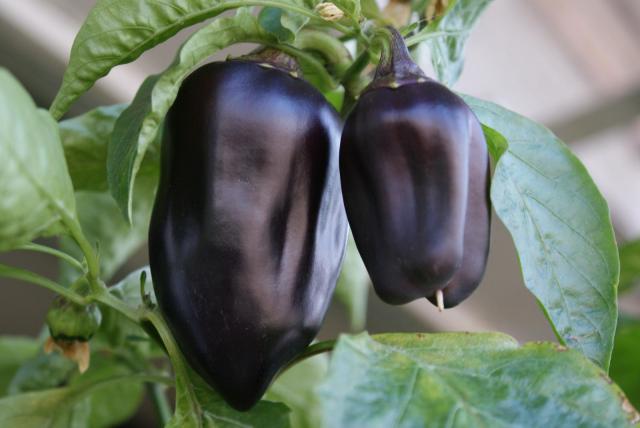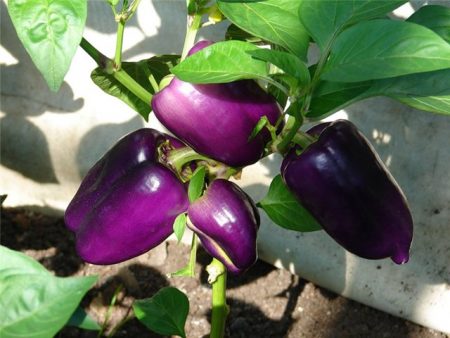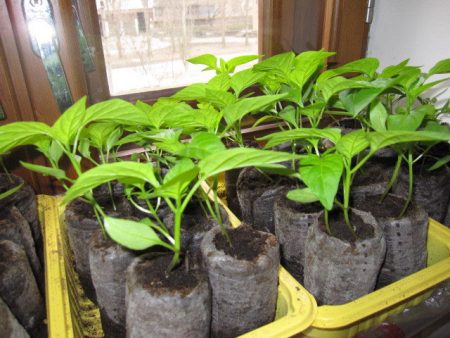 This variety is able to surprise gardeners with an unusual fruit color for the pepper - purple. This unique feature is capable of adding variety to dishes prepared from it. But these fruits not only have an attractive appearance, but also have many vitamins and minerals that the human body needs.
This variety is able to surprise gardeners with an unusual fruit color for the pepper - purple. This unique feature is capable of adding variety to dishes prepared from it. But these fruits not only have an attractive appearance, but also have many vitamins and minerals that the human body needs.
The regular use of pepper in food can significantly affect the overall physical and mental state.
Grade description
Bucharest pepper is suitable for raising it on the balcony, as well as on the windowsill of the apartment. If you grow it in a pot, then the height of the bush rarely exceeds 50 cm. This plant is small, semi-spreading. It only needs to be removed side branches before branching.
If you want to grow pepper on the windowsill, you should choose sunny windows. You can also use the backlight. Thus, the falling of the ovary and buds can be prevented.
Also, pepper of this variety is suitable for growing in a greenhouse and open ground. Under these conditions, bushes reach 110 cm.
Bucharest is a precocious variety. From the appearance of the first sprouts to the crop, about 110-115 days pass.
You can collect peppers of a rare purple color, or you can wait until its biological maturity, at which time the fruits become bright red.
Pepper has a conical shape, the weight of the fruit is about 150 g. The surface has a shiny, smooth, 2-3 chambers, walls with a thickness of about 6 mm. Perfectly tolerate transportation.
The fruits taste great. Suitable for cooking fresh vegetable salads, as well as for canning and freezing.
Bucharest's yield is 4.1 kg / m2.
The most important rules for growing pepper in the open ground
- The choice of beds for planting. For this plant, you need to choose a sunny and calm place. Bucharest is quite a heat-loving variety, and also does not tolerate drafts, especially during fruiting.
- Soil requirements. Sandy and loamy soil is suitable for the plant. But the best for him would be black earth, which has a light composition. The soil should not be too acidic, better optimally neutral. Also, too wet soil will not work.
- Growing seedlings
For further cultivation in a greenhouse, seeds for seedlings need to be sown in February. If further cultivation will occur on the windowsill - you can choose any time of the year.
Seeds can be sown in peat tablets. To do this, use special soil or make it yourself. To do this, mix humus, chernozem, sand and peat in approximately equal proportions. Next, it should be laid out in containers prepared for landing. Water abundantly and make small indentations to put seeds there, sprinkle with a small layer of soil.
- Hardening. This action is necessary seedlings, which will continue to grow in the open ground. It should begin two weeks before planting. First of all, you need to open the window every day for 15 minutes. Further time gradually increases.
- On the 40-50th day, the bush is ready for transplanting into the open ground. Landing is best in the morning on a not too hot day.Between the holes should be about 35 cm, and between rows about 50 cm. The most active growth of pepper is observed at a temperature of + 20 + 25 degrees or higher. But lower temperatures can slow down plant growth.
If it is predicted that the night temperature is not expected to be high, it is advisable to cover the seedlings.
- Watering. The sprinkling method is suitable for this.

The scheme is as follows:
- young seedlings need to be watered once a week. In hot weather - twice;
- during flowering - three times;
- during fruiting, watering is carried out about four times during the week.
- Top dressing. It is also carried out according to a scheme that depends on the vegetative period:
- when the ovary appears - infusions of herbs, mullein, wood ash;
- during the formation of fruits - bird droppings in the form of a solution or mullein. For the entire growing season, about five top dressings are done with an interval of about 10 days.
- Pests and diseases. Pepper came to taste not only to people, but also to various pests. These are trips, scoops, bears and Colorado beetles.
It is also susceptible to diseases such as late blight, tobacco mosaic, powdery mildew, black leg, various rot.
Attention! The plant is transplanted into the greenhouse in early May. If you plan to grow pepper on the windowsill, you should transplant the plant in a five liter pot.
Reviews
Natalia, 44 years old, Cheboksary
I read the characteristics of the variety and I was very interested that Bucharest can be grown on the windowsill. I decided to grow a plant on the windowsill of a city apartment, since we have a summer residence. The bush grows a small, fruit of a very interesting purple hue. Of course, there was not much harvest, but until the winter he pleased us with vitamins.
Leonid, 58 years old, Ivanovo
He grew seedlings for further planting in the greenhouse. Not too large bushes grew, only about a meter high. The fruits had an unusual purple hue, but my family prefers ripe ones - they are bright red. In general, I liked the variety.
Irina, 38 years old, Mr. Tula
Planted pepper seedlings in the open ground. Harvest is good. She made preparations for the winter in the form of conservation, and froze some. All liked it.
Daria, 29 years old, Oryol
Bucharest was planted in the country in the ground. They did not expect frost and did not cover the pepper. Naturally, the plants froze. But my mother and I decided not to get rid of these bushes. And they were pleasantly surprised when they all left and even pleased with the harvest.




 Calorie pepper stuffed with meat and rice - BZHU per 100 grams
Calorie pepper stuffed with meat and rice - BZHU per 100 grams Gorky pepper - the best varieties for open ground
Gorky pepper - the best varieties for open ground Hot pepper seeds - the best varieties for open ground and reviews
Hot pepper seeds - the best varieties for open ground and reviews Capsicum tincture for hair - how to use and reviews
Capsicum tincture for hair - how to use and reviews